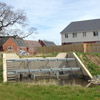
Flow controls help offset extensive flood problems
After existing drainage scheme failed to prevent extensive flooding in the area as recently as 2012/2013, Telford and Wrekin planners put a condition on the approval to provide a scheme to resolve the flooding issues.
Complex flow control chambers such as the one designed for Limekiln Lane are being used increasingly.
Consulting engineers Mouchel established an innovative solution based on Sustainable Drainage Systems (SuDS) principles. The system uses a configuration of three Hydro-Brake Optimum flow controls to optimise the existing back up storage volume and provide enhanced protection for the built up areas downstream.
Robust flood protection
The existing arrangement was that normal dry weather flow followed the stream course with an arrangement which allowed overflow into a dry swale. The overflow was then discharged into a bypass system of 1200 mm diameter pipes. However, the perched nature of the stream had resulted in long-term flooding when the banks were breached.
Mouchel were challenged to deliver a robust flood protection scheme using the maximum storage available within a specific area allocated on the site, which sits between a housing development and new school playing fields. The new drainage design also had to ensure that normal stream flows could continue downstream with no restriction in light flow conditions for ecology and amenity purposes.
The existing drainage scheme was failing to prevent flooding through a nearby recent housing development
Neil Scott, Principal Engineer for Mouchel, discussed why Hydro-Brake Optimum was specified for the scheme: As you get more flow at a lower head through the Hydro-Brake Optimum, less back up storage is required. So, the discharge from the basin could be carefully controlled to make the most of the storage capacity available.
The maximum stored volume of 6,700 m3 was the total amount which could be accommodated within the area and the maximum combined continuation flow was 1.75 m3 per second. The maximum depth of water which could be achieved on the site is 2.2 m.
With these parameters in mind, Mouchel decided to split the flow so that normal flow and flood flows activated separate flow controls installed in a concrete headwall structure to provide additional protection when required.
With the help of Hydro’s technical design support, we devised a headwall arrangement with one flow control unit providing the continuation flow discharging at a maximum of 584 l/s through a 900 mm pipe, and units two and three on the other side of the shallow weir wall activated during peak events.
The normal surface water intake is channelled through the continuation unit into the existing watercourse. When the flow overtops the shallow weir wall, Hydro-Brake Optimum units two and three come into operation before combining and discharging into the 1200 mm pipe into a previously redundant overflow culvert, brought into more effective use as part of the scheme.
With all units set at the same level the flow is always split 33/66 as soon as the water level overtops the weir level.
Latest news

22nd November 2024
Insight Data: Using Marketing Data to Build a Successful Business in 2025
Alex Tremlett, Insight Data’s Commercial Director, discusses the challenges for construction firms in 2025 and shares six strategies for success…
Posted in Articles, Building Industry News, Building Services, Information Technology, news, Research & Materials Testing
22nd November 2024
Purplex: A tough Budget, but opportunity still knocks
Incoming governments, especially those with significant mandates, inevitably come into power on a tidal wave of optimism coupled with hope that ‘Things can only get better’. Andrew Scott, MD of construction-focused, full-service agency Purplex, talks…
Posted in Articles, Building Industry News, Building Services, Information Technology, news, Posts, Research & Materials Testing
22nd November 2024
Pop Up Power Supplies Gets Arty in Yorkshire
Pop Up Power Supplies has installed 13 new electricity units at The Hepworth Wakefield – read more in this article…
Posted in Articles, Building Industry News, Building Products & Structures, Building Services, Case Studies, Civil Engineering, Facility Management & Building Services, Garden, Hard Landscaping & Walkways, Landscaping, Posts, Restoration & Refurbishment, Retrofit & Renovation
22nd November 2024
OPT Services Revolutionises Fibre Cable Capping with Eco-Friendly Innovation
UK-based OPT Services has unveiled SlimLine™ Capping, a groundbreaking fibre cable protection solution that promises to deliver significant environmental and installation advantages to the fibre optic industry.
Posted in Articles, Building Industry News, Building Products & Structures, Building Services, Facility Management & Building Services, Information Technology, Innovations & New Products, Sustainability & Energy Efficiency
 Sign up:
Sign up: